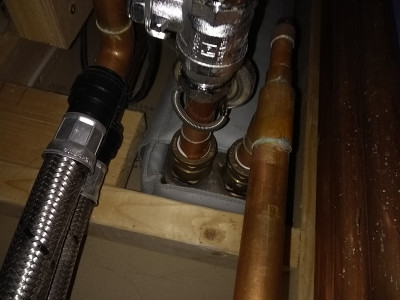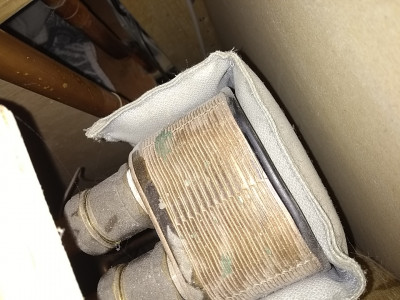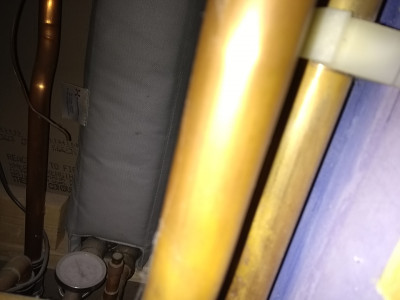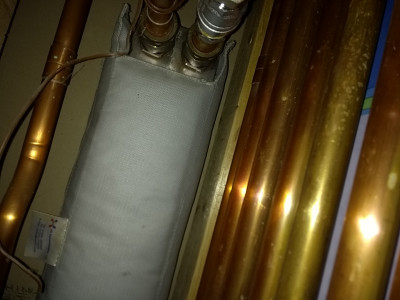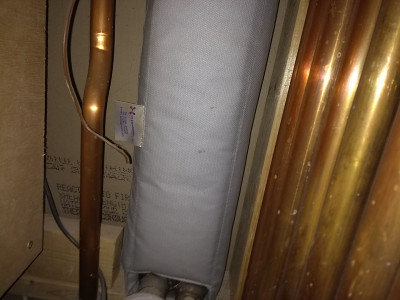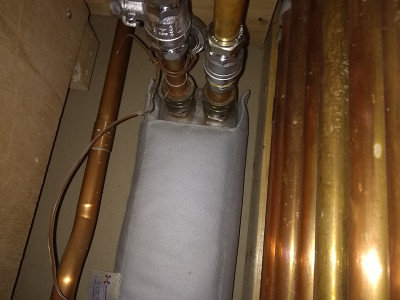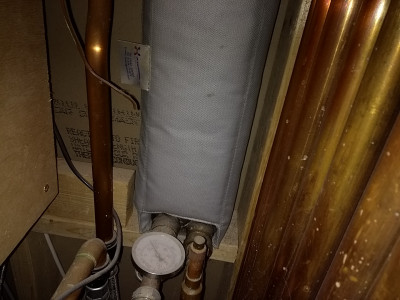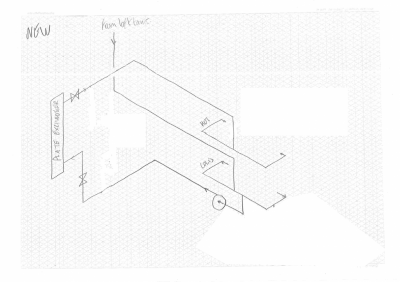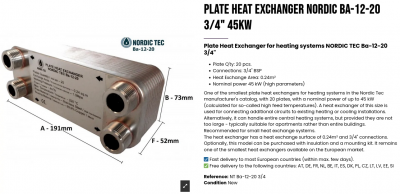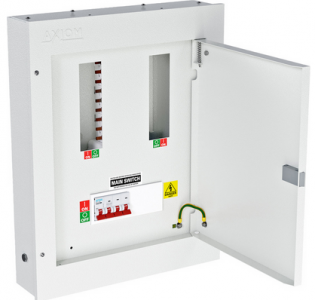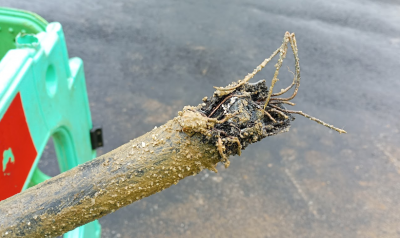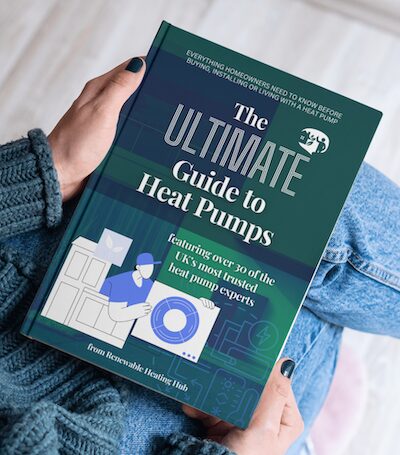@Transparent it's an interesting proposal. I don't think the energy balance quite works.
The radiators and hot water tap remove energy from the system.
The ASHP adds energy to the system.
HP2 increases the temperature of the stream, but the only energy it adds to the whole circuit is the electrical energy to power it's compressor.
Or to put it another way, the only energy getting into this system is the electrical energy to both heat pumps and the "air cooling" of the ASHP.
I have a system designed for 4 showers one after the other. It's a 200L cylinder, a large plate heat exchanger and a 35kW gas condensing boiler. I also have nearly 200L of cold water storage to supply the fresh water to the system.
Regards
Bob
Can we have a photo of that plate heat exchanger please @bobtskutter ?
Plus your comments on why this is preferable to having a coil inside the cylinder 🙂
Save energy... recycle electrons!
Sure, here's bunch of pictures. The plate exchanger is shoe horned into the back of the airing cupboard, it's not easy to get photos of.
When this was installed, high surface area indirect DHW cylinders didn't exist, so trying to get 35kW into a hot water cylinder wasn't going to happen. The pipework is configured so the cold feed to the cylinder goes into the suction of the shunt pump to the PEX. That way when the system is on reheat the cold water goes through the PEX before it's "buffered" in the tank.
The system can supply about 16L/min (I think) via a booster pump to the shower, and all other DHW outlets (x3 taps) simultaneously via gravity feed. The water supply to the house can provide about 12L/min so there's 200L of water in tanks in the loft. It's a proper "over engineered" job.
Regards
Bob
Thanks Bob.
For such an elderly plate heat exchanger, yours is in a cupboard which is remarkably free of cobwebs!
So that others can see what we're talking about, here's a unit from the Nordic website
Choosing a heat-exchanger would normally involve selecting from the following parameters:
- total surface area of plates in the unit
- heat transfer capacity in kW (check the temperature range at which this was calculated)
- size of couplings (an indication of how much flow it can handle)
- overall dimensions (will it fit in the available space?)
There are a number of advantages over using a coil inside a cylinder:
- plate heat exchangers can be retro-fitted to existing cylinders when the heating system is 'upgraded'
- if connected with isolation valves, the heat-exchanger can be replaced without changing the cylinder (and vice versa)
- additional plate heat exchangers can be added later to increase the number of heat sources (eg adding solar thermal)
- the heat exchanger can be equipped with its own temperature and/or flow sensors (so you can see what's happening when things don't work as you expect)
- having an overly-large plate heat-exchanger is cheaper than having a tank with a large coil
If I was installing my heating system all over again, I'd be using plate heat exchangers and a 'standard' tank rather than buying a 'specialist' cylinder with a coil of the appropriate size.
Changing from a boiler source to a heat-pump would be much easier.
The lower water temperature could be accommodated by swapping the heat exchanger for one with greater plate surface area.
(@editor may wish to note these comments when considering your next installation)
Save energy... recycle electrons!
@transparent Yes, all those reasons crossed my mind when I was designing the original system.
To answer your original question, please see the attached spreadsheet.
The calculation assumes continuous water flow, any time between showers will allow the buffer to recharge.
I've set the ASHP power at 12kW, because that seems to be the max you can get from a single phase 240V supply.
The calculation is an energy balance including the accumulated energy in the buffer tank. Once the tank has cooled to the shower temperature the shower will start to go cold.
Everything in yellow can be changed.
Regards
Bob
Thanks Bob.
Could you just clarify what you mean by setting "the ASHP power at 12kW"?
Yes, I appreciate that 12kW may well be the largest you'd supply from single phase, but -
You've said that you actually have a (35kW!) gas boiler...
... and your spreadsheet has a whopping 55°C for the temperature in a buffer tank.
If I was to have a 12kW ASHP, I wouldn't be running it such that a buffer tank is that hot.
It would be too inefficient.
[Aside] I wish everyone would upgrade to 3-phase when having a heat-pump installed.
Not only will the compressor and fan motor be more efficient,
but we can also reduce the losses due to phase imbalance at the local substation transformer.
Save energy... recycle electrons!
Ah....yes, sorry. The spreadsheet is actually a generic calculation. My comment "the ASHP power at 12kW" was me trying to say "I've limited the input power to 12kW"...because that's roughly what you get from a single phase 240v supply.
Everything in the sheet is adjustable, so you can play with it to find out what works.
In my case it would be a 200L cylinder, 50C buffer, 5C cold water and 24.5kW boiler. At those settings the system never runs out of hot water!
Bob
A slight distraction:
But just to show what high temperature heat pumps can really do!
Bob
Posted by: @transparent[Aside] I wish everyone would upgrade to 3-phase when having a heat-pump installed.
Not only will the compressor and fan motor be more efficient,
but we can also reduce the losses due to phase imbalance at the local substation transformer.
Does the dno do this free of charge?
4kW peak of solar PV since 2011; EV and a 1930s house which has been partially renovated to improve its efficiency. 7kW Vaillant heat pump.
Posted by: @transparent[Aside] I wish everyone would upgrade to 3-phase when having a heat-pump installed.
Not only will the compressor and fan motor be more efficient,
but we can also reduce the losses due to phase imbalance at the local substation transformer.
Does the dno do this free of charge?
4kW peak of solar PV since 2011; EV and a 1930s house which has been partially renovated to improve its efficiency. 7kW Vaillant heat pump.
Yes. DNOs are very keen to upgrade domestic properties to 3-phase.
The swapping of the Smart Meter to a 3-phase device is also free, and gets done by your Energy Supplier.
But note the following two observations:
A: The internal changes to the wiring in your house still needs to be done by an electrician who you pay for.
Sometimes they go 'over the top' and insist that you need an unsightly, very large commercial 3-phase consumer unit.
That's not true, and I have it in writing from a very senior engineer at National Grid.
If it's just the new heat-pump which is actually going to operating on 3ph, then it can have its own small consumer unit with a switch disconnector and MCB.
You might want the rest of the house to have its load spread across two or three phases.
But you can use two or three small separate consumer units for that.
A domestic 3ph Smart Meter is 'vector sum' in operation.
If your single-phase PV-inverter is exporting to the grid on 1 phase,
and your EV charger is importing on another,
then you only pay for the difference in power across the phases.
B: If your house is on a new estate where the electricity infrastructure was put in place by an Independent Distribution Network Operator (IDNO), then you are likely to be charged for them running a new 3-ph cable from the road.
Depending on the contract between the Developer and the IDNO, the estate management company may also have obligations, such as re-surfacing the road if it hasn't been adopted by the local authority. Their income comes from the annual estate maintenance fees paid by each household. So your actions can incur increased maintenance charges for everyone next year.
The IDNOs know this.
They are cheaper for Developers to employ because they use thinner cables and only run a single-phase to each property.
Whereas it's now common practice for the 14 regional DNOs to install a 3ph cable, and simply leave two of the wires 'capped' within each home's Service Fuse.
The IDNOs can make substantial profits over the years from the maintenance charges.
They know that the underground cables will all need upgrading as consumers migrate to EVs and heat-pumps in future.
The above cable is probably 95mm² or 120mm² and was installed by an IDNO.
The local DNO engineer, who was called to repair this break, said that they would normally have used 240mm² or 300mm² in this location, which was about 100m from the local substation transformer.
Save energy... recycle electrons!
@ Transparent While I appreciate the idea, I would imagine that that the availability of 4-phase ASHPs (compared to their single-phase siblings) may be a relevant consideration. A battery (in particular, an 'AC' one, like mine) would pose a further complication.
- 26 Forums
- 2,364 Topics
- 53.6 K Posts
- 236 Online
- 6,027 Members
Join Us!
Worth Watching
Latest Posts
-
RE: Need Help Optimising My Rushed ECO4 Install: 12kW Bosch Heat Pump
Welcome @mickamills We too have an oversized 12kW Sa...
By Old_Scientist , 1 hour ago
-
RE: My Powerwall 3 Consumes 3-4 kWh/Day in Self-Consumption: Is This Normal?
@caron I can confirm that the power usage of the PW3 is...
By Old_Scientist , 1 hour ago
-
RE: Balancing financial efficiency and comfort using the Octopus Cosy tariff
Looking at your figures, I'm guessing you'd ideally nee...
By Old_Scientist , 2 hours ago
-
I agree, I'm equally predisposed to a cold sunny winter...
By Old_Scientist , 3 hours ago
-
RE: Octopus Cosy Heat Pump Owners & Discussion Thread
@andrewj they will release smarter controls, its been m...
By swwils , 5 hours ago
-
RE: Speedcomfort radiator fans
Thats true, but having tried (and succeeded) in constru...
By JamesPa , 5 hours ago
-
RE: Solis S6-EH1P8K-L-PLUS – Why I Chose It and What I’ve Learned So Far
@bash brilliant, thanks for the feedback
By energy9165 , 7 hours ago
-

RE: Setback savings - fact or fiction?
The OpenWeatherMap API provides plenty of historical da...
By Majordennisbloodnok , 7 hours ago
-

RE: Heat Pump Heats the House… But It’s Not Cosy. Emitter Changes or System Tweak?
@alastair There I was, feeling grumpy, he said “Cheer u...
By Toodles , 9 hours ago
-
RE: Grant Aerona: Is there a setting to keep the 2-port valve open during pump blockade
Depends on OAT. Mine cycles at OAT>10 and of course...
By JamesPa , 10 hours ago
-
RE: New Fogstar 15.5kWh upright solution
@transparent My conclusion is as you have noted, tha...
By Bash , 11 hours ago
-

That makes sense to me,although we don't know what the ...
By Transparent , 13 hours ago
-
RE: Mitsubishi Ecodan R290 10kW performance
And to you too. Wishing you a very enjoyable festive s...
By Sheriff Fatman , 13 hours ago
-

RE: External pipework insulation
They do? But that isn't apparent from the photos we'r...
By Transparent , 15 hours ago
-

RE: Say hello and introduce yourself
@velcro welcome to the forums. Please feel free start a...
By Mars , 1 day ago
-
Daikin EDLA11D3V3 DHW Settings
I have a newly installed EDLA11D3V3 which I'm still get...
By Velcro , 1 day ago
-
RE: Midea ASHP – how to set weather compensation
@curlykatie did you get sorted with this?
By MickaMills , 1 day ago
-
RE: MyVaillant Connect Regular Disconnect
Thanks. Yes, if the time is consistently 11pm every nig...
By buckwem , 2 days ago

